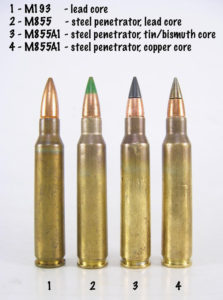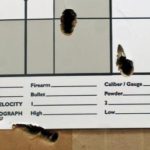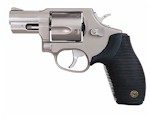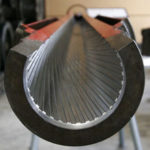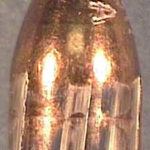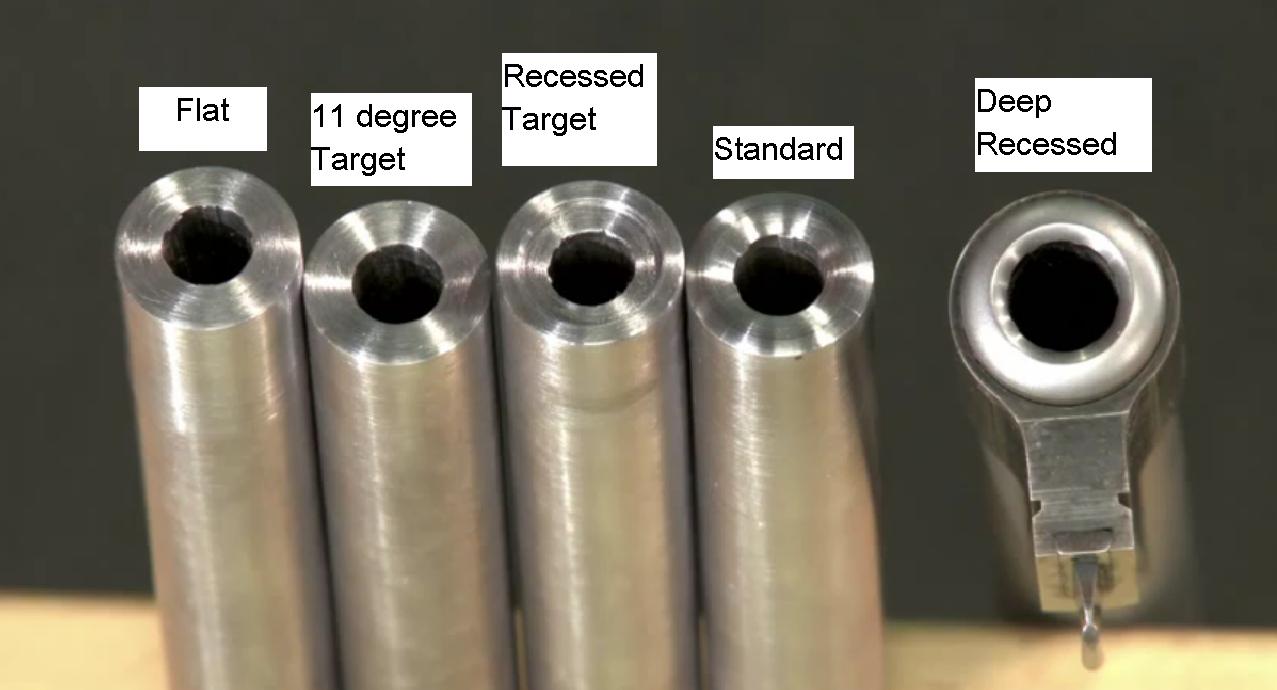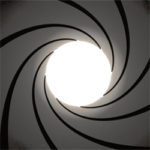 So, you are having a discussion with your shooting buddy after a round of range Kata. You mention to him that you wish your favorite firearm had better accuracy. Being a humble soul, your shooting buddy may respond with something to the effect of; “Yousah, Man! You need to buy a firearm like my custom “Bubba Bear Brown” that has a 6.128-inch barrel with twenty-seven lands and grooves and a twist rate of 1:7.265. When Einstein formed his E=MC2 theory, this pistol is what he used! Why with my custom-loaded thirty-seven and point-two-seven-five caliber round, this thing produces so much energy that I just get tired thinking about it! In fact, NASA wants this gun banned because the shock wave from the muzzle blast is causing satellites to shift in their orbits!”
So, you are having a discussion with your shooting buddy after a round of range Kata. You mention to him that you wish your favorite firearm had better accuracy. Being a humble soul, your shooting buddy may respond with something to the effect of; “Yousah, Man! You need to buy a firearm like my custom “Bubba Bear Brown” that has a 6.128-inch barrel with twenty-seven lands and grooves and a twist rate of 1:7.265. When Einstein formed his E=MC2 theory, this pistol is what he used! Why with my custom-loaded thirty-seven and point-two-seven-five caliber round, this thing produces so much energy that I just get tired thinking about it! In fact, NASA wants this gun banned because the shock wave from the muzzle blast is causing satellites to shift in their orbits!”
Where do you go from there?
What I want to attempt here is to present some things that I (and others) consider as what makes up an accurate barrel, which is more than just one thing. The article is not all-encompassing base-line reference source; simply a projection of the tip of the ballistics iceberg. Besides, you could just be my shooting buddy one day and we can have an intelligent conversation about what makes a barrel accurate. All things being relative, what you will read are simply some mechanical aspects of barrel accuracy, but it is well known that a good shooter can make a bad firearm shoot good while a bad shooter can make a good firearm shoot bad – regardless of stated ballistics.
SO WHAT MAKES A BARREL ACCURATE?
The most important factors for a barrel to be accurate, according to Dr. F.W. Mann, who did 38 years of research on the subject, are:
- Straightness
- Uniformity of the bore and rifling
- Twist rate matched to bullet length and velocity
- A choked muzzle and a uniform forcing cone with graduated rifling (called a leade) at the end of the chamber
Assuming that we have a straight barrel, let’s start out with rifling and then move on from there. At which point, you will discover the answer to the question in the sub-title of this article.
Rifling has taken us from launching little round lead balls at relatively short distances to launching pointy projectiles extremely long distances.
In rifled barrels, the number of lands and grooves MAKES ABSOLUTELY NO DIFFERENCE, as far as accuracy is concerned. That’s assuming that the minimum number of lands and grooves is adequate to stabilize the bullet.
In World War II, the U.S. Army proved that two lands and grooves were enough to stabilize a 150-grain bullet in a .30/06 rifle. They accepted two-groove barrels in their Springfield 03A3 rifles because they could be produced faster than four-groove barrels (the previous standard). The decision-makers admitted that these rifle barrels were not absolutely the most accurate they could produce, and that the four-groove barrels they replaced were no more accurate?
One rifling twist story that I read involves the .223 Remington, called the 5.56mm NATO by the military. This cartridge was designed specifically for use with 55 grain spitzer bullets and its twist rate was originally specified as 1:14″. This was later tightened to 1:12″ for long range shooting, which works very well with bullets weighing 40-60 grains, the usual .22 center-fire bullet weight range.
Years later, the military decided they needed more penetration, so they increased the normal service cartridge bullet weight to 62 grains and some military cartridges use bullets at heavy as 77 grains. The standard 1:12″ twist could not properly stabilize these heavy bullets, so the military went to a 1:7″ twist, designed to stabilize bullets weighing 62-77 grains. Most manufacturers of AR-15 type civilian rifles followed suit.
Unfortunately, 1:7″ is too fast for frangible varmint bullets, so now we have two “standard” twist rates for .223 rifles: 1:12″ for varmint rifles and 1:7″ for military type rifles. The latter are often, but not always, stamped “5.56mm.”
In the civilian world, and as an example, Sturm Ruger offers a MSR (AR-556 and SR-556) in a 1:8 RH twist 6-groove barrel configuration. The Ruger American, a bolt-action rifle that is chambered in .223, also exhibits a 1:8 RH twist with 6 groove barrel. The 1:8 twist rate seems to be a trade-off point for handling both light and heavy bullet weights.
The twist rate of the barrel seems to be of more importance than the number of lands and groves, when it all comes down to it and as far as rifling is concerned. Early on, it was found that two lands and grooves are all that is minimally needed to impart spin on a bullet speeding out of any gun barrel.
The barrel twist starts the bullet spinning at a given rate to stabilize the bullet. The rate must be constant for the utmost accuracy in most cases. Of course, there are exceptions.
Listed below are twist rates for most of the popular calibers (compliments Brownells). Note that the following list is but a small part of the overall twist rate picture.
As a general rule:
The higher the velocity, the slower twist is required.
The lower the velocity, the faster twist is required.
Caliber Twist
.172
10″ For all bullets
.22 RF
14″* Twist for pistol barrels
16″ Standard twist for rifle barrels
17″* Special twist for rifle barrels
.224 CF
9″ For bullets heavier than 63 gr.
12″ For bullets up to 63 gr.
14″ For bullets up to 55 gr.
15″* For bullets up to 55 gr. driven 4,100 fps or more
16″* For bullets up to 55 gr. driven 4,300 fps or more
6mm/.243
8″ Special for VLD bullets
10″ For bullets up to 120 gr.
12″ For bullets up to 85 gr.
13″* For bullets up to 75 gr.
14″* For bullets up to 70 gr.
15″* Special for bullets up to 70 gr.
.257
9″ For bullets heavier than 100 gr.
10″ For bullets up to 105 gr.
12″ For bullets up to 90 gr.
13″* For bullets up to 80 gr.
14″* For bullets up to 70 gr.
6.5mm/.264
8″ For bullets heavier than 120 gr.
9″ For bullets up to 120 gr.
.270
10″ For all bullets
7mm/.284
9″ For bullets heavier than 140 gr.
11″ For bullets up to 140 gr.
.307
13″* Special size and twist
.308
8″ For bullets heavier than 220 gr.
10″ For bullets up to 220 gr.
12″ For bullets up to 170 gr.
14″* For bullets up to 168 gr.
15″* For bullets up to 150 gr.
7.65mm/.311
10″ For all bullets
.338
10″ For all bullets
9mm/.355
14″ For low-velocity wadcutters
16″ For all other bullets
.38/.357
14″ For low-velocity wadcutters
18″ For all other bullets
.358
14″ For all bullets
.375
12″ For all bullets
10mm/.400
16″ For all bullets
.411
14″ For all bullets
.416
14″ For all bullets
.44
20″ For all bullets
.451
16″ For all bullets
.458
14″ For all bullets
*Stainless Steel only
Black Powder Barrels (1.250″ x 30″)
.32
14″ .320″ groove
.38
20″ .379″ groove
.40
20″ .403″ groove
.457
20″ .457″ groove
What is interesting to note is that some twist rates in rifle barrel are also found in handgun barrels.
Twist rate; however, is dependent on the factors shown in the following calculation:
What twist rate that is incorporated into your firearm’s barrel may not necessarily be the correct twist rate for the bullet(s) that you are shooting.
The twist rate of Colt .38/.357 magnum revolvers is 1:14, because that’s what their old tooling was and it’s always been that way. The Colts give the best accuracy with wadcutter and 158-gr lead bullets.
Ruger single-action .357s are 1:16 and are button rifled, because that is what the standard twist is on .35 cal. rifle bores from the people who grind the button rifling heads, and they bought the buttoned blanks from various makers and that’s what was available.
Ruger double-action .38/.357s, Security Six, Police Service Six, Speed Six, GP100 and SP101 are 1:18-3/4″ twist, as are Smith and Wesson revolvers. The reason Ruger went with 18-3/4 inch twist on the Double-Action revolvers is because this is the pitch on the rifling broach cutters and there is only one company that makes them. The 18-3/4 twist gives better accuracy with the lighter +P jacketed loads, 110-125 grain bullets, which most people shoot. For good 50-yard grouping with wad-cutters, you may need to drive bullets a bit faster than factory to maintain stability.
You can see from the listing of (typical) handgun twist rates that there is a substantial difference in twist rates between 9mm and .45 acp calibers. But, one thing that should be noted is that bullet weight is not a factor. One could presume, then, that a 147-grain 9mm cartridge would perform the same as a 90-grain 9mm bullet out of the same barrel – if the velocity is the same for each bullet and each bullet was identical in construction; sans, the weight difference. Reality; however, differs from presumption. There are just too many other variables that affect bullet performance; twist rate is only one of the factors and that takes more physics than I care to spend time learning.
Twist rates in rifle calibers, somehow, make more sense to me than twist rates for handguns.
BULLETS WELL SHOT ARE BULLETS WELL EARNED:
Let’s face it, firearms manufactures know what they are doing when it comes to squeezing the most performance out of ammunition intended for a specific firearm. Returning to the twist rate formula shown earlier, we can define the variables:
Where:
T = Twist rate in 1 turn per inches.
L = Bullet length in inches.
V = Muzzle Velocity
D = Diameter of the bore grooves in inches.
Constant = 3.5
From this formula, we can also find the following:
- The optimum bullet length from velocity, bore size and twist rate: L = (3.5 * SqRt( V ) * D²) ÷ T
- The optimum muzzle velocity from bullet length, bore size and twist rate: V = (L * T ÷ D² ÷ 3.5)²
- A different constant to fit known optimum combinations: Constant = L * T ÷ D² ÷ SqRt( V )
Tests show that, with the 80-90gr bullets, a 1:10 or 1:12 barrel will give you as much as 80fps more velocity than a 1:8 barrel, shooting the exact same loads. Fast twist (1:8) barrels have more drag and friction, which can slow the bullet down. Ideally you want to use the slowest twist rate possible that will stabilize the bullet you choose to shoot.
PUTTING A POSITIVE SPIN ON THINGS
 Subsequent to twist rate is spin rate, the speed at which a bullet spins when it leaves the barrel. That is not to say that twist rate and spin rate is the same, but only that twist rate is a variable used in determining spin rate in revolutions per minute (RPM)
Subsequent to twist rate is spin rate, the speed at which a bullet spins when it leaves the barrel. That is not to say that twist rate and spin rate is the same, but only that twist rate is a variable used in determining spin rate in revolutions per minute (RPM)
Here is a simple formula for calculating bullet RPM:
MV x (12/TR) x 60 = Bullet RPM
-or-
RPM = MV X 720/TR
Where:
MV = Muzzle Velocity
TR = Twist Rate in inches
As an example, a bullet will make one complete revolution for every 12″ (or 1 foot) it travels through the bore in a 1:12″ twist barrel. With a velocity of 3000 feet per second (FPS), in a 1:12″ twist barrel, the bullet will spin 3000 revolutions per SECOND (because it is traveling exactly one foot, and thereby making one complete revolution, in 1/3000 of a second). To convert to RPM, simply multiply by 60 since there are 60 seconds in a minute. Thus, at 3000 FPS, a bullet will be spinning at 3000 x 60, or 180,000 RPM, when it leaves the barrel.
In a second example, the twist rate is increased 1:8″ twist. We know the bullet will be spinning faster than in the first example, but how much faster? Use the bullet spin formula to find out. Assuming the same MV of 3000 FPS, the bullet makes 12/8 or 1.5 revolutions for each 12″ or one foot it travels in the bore. Accordingly, the RPM is 3000 x (12/8) x 60, or 270,000 RPM.
That is a gain of 90,000 RPM in a barrel with a 1:18 twist rate over a barrel with a 1:12 twist rate. So, we now have a projectile traveling at a rate of 3000 fps with a rotation of 270,000 RPM in a 1:8 twist rate barrel as compared to a projectile traveling at the same speed but a slower bullet spin rate. One could surmise that the former would be more stable at longer distances than the latter. I wish it were that simple.
LETTING MY THOUGHTS (AND BULLETS) DRIFT
Most of us who shoot at short ranges need not to worry about “Spin Drift” and “Wind Drift” as much as long range-shooters. Wind drift is pretty self-explanatory, but when coupled with a bullet’s natural spin drift, “Kentucky Windage” takes on a whole new meaning.
A technical description of “spin Drift” follows (courtesy of http://guns.wikia.com/wiki/Spin_drift):
Spin drift (also called “gyroscopic drift”) is caused by the spin of a bullet or projectile. The surface of a spinning bullet spins the air around it. Because the air can not continuously spin around the bullet in a constant motion a low pressure point evolves in the direction of the spin. The bullet, by way of higher pressure, must move in the direction of the low pressure. If a bullet or shell has right hand rifling then it will drift to the right. The same is true for left hand rifling. The impact of spin drift can be more than eight inches for a 1,000-yard distance.
Typically spin drift starts to be observed at about 600 yd (550 m). The slower the rifling twist rate (for example, 1:7 as opposed to 1:13) the greater the drift. This is actually the same effect as the curve ball in baseball. On a baseball, the stitching sticks out and ‘grips’ the air. The bullet has been deformed a bit by the rifling which results in the same thing. It is also called the Bernoulli Effect, and is the reason airplanes fly. It is the difference in air speed felt by the top and bottom of the wing, due to wing shape, which results in a pressure difference, causing a force perpendicular to the direction of motion. With an airplane the force is up, with a firearm the force is to the left or right.
Since this article is not about long-range shooting, I am just going to leave “Spin Drift” for others to share.
HOLY TUMBLEBULLETS, BATMAN!
I was shooting some re-loaded .45 acp cartridges during one range session; whereupon, I noticed that several rounds produced “key holes” in the target. I was shooting from a distance of 15-yards and that was the last thing that I expected at that close of distance. Only a few rounds caused the key-holing, and it was soon forgotten. However, “key-holing” is a ballistic battle that we sometimes face and it is caused by the bullet “tumbling” through the air to some degree. With that said, bullets fired from a rifled firearm should NOT tumble in flight. If they do so, it is a sign of issues that may be caused by the rifling in the firearm, and/or the bullet.
If the bore is oversized for the bullet, or if rifling is badly fouled with lead/jacketing metal/powder deposits, the bullet will not be gripped by the rifling and spun, and may not be stable in flight (tumbling) Try cleaning the bore properly, and check for excessive wear at the muzzle.
The bullet may be wrong weight/length for the rate of twist of the rifling. A fast rate of twist, combined with a very fast bullet, MAY result in the bullet “stripping”, and not being spun by the rifling. Or a very heavy, slow bullet may not be spun fast enough to stabilize the bullet. Most .22 rimfire rifles are rifled to shoot 40 grain bullets accurately. If loaded with a 60 grain bullet, such as the Aguilla 60 gr SSS, the bullet will not be stabilized, and may tumble in flight.
With my case at the range, I can only assume that several of the bullets fired were not sized correctly, as the remaining bullets left clean holes in the target with no sign of key-holing.
THE LONG AND SHORT OF IT
Just to add to everyone’s confusion, including my own, is the fact that a given cartridge used in two different firearms can provide different performance characteristics.
For example, a 125-grain .357 magnum bullet that is rated at 1500 fps out of a 4-inch barrel will have a slight increase in velocity when fired out of an 18.5-inch barrel. How can that be? The barrel is obviously longer and should exhibit more drag on the bullet. Case in point is the Ruger GP100 revolver with a 4.2-inch barrel and the Ruger M77 357 carbine with an 18.5-inch barrel. The barrel of the GP100 has a 1:18.75-inch twist rate while the M77 357 has faster twist rate of 1:16.
The GP100; however, is notable for impressive muzzle and side flashes when a round is fired. With the M77 357, the gunpowder has more chance to complete burning before the bullet leaves the muzzle and no energy is wasted through side flash as with the revolver. Also, the barrel of the M77 357 is more suitable for shooting heavier bullet weights such as a 200-grain hard-cast bullet that might be used for hunting.
Another case in point that I found interesting is the .45 acp cartridge. The original .45 acp 230-grain cartridge was intended to fire out of a 1911 pistol with a 5-inch barrel at 830 fps. This same cartridge was also fired out of the Thompson Sub-Machine Gun and the M3 “Grease” gun; both of which obviously have longer barrels and produced higher velocities than with the M1911.
My Ruger SR1911 has a 5-inch barrel. When I shoot the same ammunition from a Hi-Point carbine, there is a definite increase in bullet velocity out of the 17.5-inch barrel. How can that be? Both firearms have the same twist rate of 1:16 and the barrel of the Hi-Point carbine is longer. That should translate to a decrease in bullet velocity because a longer barrel has more influence on the bullet over a longer period of time.
The answer just might lie in the number of lands and grooves.
The Ruger SR1911 has 6 lands and grooves; whereas, the Hi-Point carbine as 9 lands and grooves. So, let’s move on to lands and grooves.
THAT’S JUST GROOVY, BABY!
Helical grooves in the barrel of a gun or firearm, which imparts a spin to a projectile around its long axis, and which subsequently, stabilizes the projectile. These helical groves comprise part of the barrel’s rifling.
These helical grooves defines the rifling twist rate, which indicates the distance the rifling takes to complete one full revolution, such as “1 turn in 10 inches” (1:10 inches), or “1 turn in 254 mm” (1:254 mm). A shorter distance indicates a “faster” twist, meaning that for a given velocity the projectile will be rotating at a higher spin rate.
The combination of length, weight and shape of a projectile determines the twist rate needed to stabilize it. Short, large-diameter projectiles, like spherical lead balls, require a very low twist rate (for example, 1:18 – 1 turn in 48 inches). Long, small-diameter bullets use twist rates of 1:8 or faster.
As a projectile is forced past the leade into the rifled portion of the barrel, the grooves “grab” the projectile; whereupon, the projectile rides the grooves until the projectile passes out of the muzzle and continues on in dynamic flight. Of course, the grooves are not simply straight, but spiral toward the muzzle and provide a spin rate (RPM) to the bullet. Spin rates can actually be calculated with a simple formula as mentioned previously:
Bullet RPM = MV x (12/twist rate in inches) x 60
So, here I have a .45 acp bullet traveling at 830 fps out of a 5-inch barrel that has a twist rate of 1:16. Doing the math, I arrive at 37,350 rpm bullet spin when the bullet leaves the barrel. Now, I chunk the same round in my Hi-Point .45 acp carbine that has the same twist rate, do the math, and the result is the same. According to this formula, the bullet spin is the same. Wait a minute! That can’t be right! I am getting an increase in velocity, but why?
The bullet is traveling down the barrel of the Hi-Point carbine with less friction and heat due to the increased number of grooves (and lands), which decreases the frictional width of the grooves. Less friction equates to more speed although the rotation (rpm) of the bullet remains the same.
Remember, the barrel of a firearm is actually a restriction. The projectile is compressed into this restriction under an enormous amount of pressure that is behind the projectile. The grooves grab the projectile and force it to turn at the barrel’s rate of twist. Once the projectile leaves the barrel it falls under a different set of restrictions. What we want to do is to give the projectile the best chance to leave the barrel as quickly as possible and leave a lasting impression on our target.
Even shotguns benefit from rifling and shotgun slugs are available for rifled shotgun barrels and rifled slugs are available for smoothbore barrels.
Twist rates and bullet spin rates vary by caliber, as was noted earlier. My Ruger SR1911 in .45 acp has a twist rate of 1:16; whereas the SR1911 in 9mm has a twist rate of 1:10. Obviously the 9mm is a lighter, smaller, and faster projectile and needs a faster twist rate than the .45 acp. It is interesting to note that the barrels of both pistols have the same 6 land and groove configuration, which goes back to the old adage, “It’s not what you have it is how it is used.”
LEAVING A LASTING IMPRESSION
A bullet is slightly larger in diameter than the bore diameter of the barrel in which it is designed to be fired. The bore diameter is the distance from one land to the opposite land in a barrel. As a result, a rifled barrel will impress a negative impression of itself on the sides of the bullet like those seen in the accompanying image. Every projectile, when fired, takes on the characteristics of the barrel it was fired from, among other things. When the projectile is swaged into the rifling, it takes on a mirror image of the rifling, as the lands push into the projectile in a process called engraving. Engraving takes on not only the major features of the bore, such as the lands and grooves, but also minor features, like scratches and tool marks.
What is important to note is that not all rifling is created equal. The 6 lands and grooves of a given barrel may not be the same as the 6 lands and grooves of another barrel. This goes back to the twist rate and how the barrel manufacturer rifles the barrel.
Most rifling is created by either:
- Cutting one groove at a time with a machine tool (cut rifling or single point cut rifling);
- Cutting all grooves in one pass with a special progressive broaching bit (broached rifling);
- Pressing all grooves at once with a tool called a “button” that is pushed or pulled down the barrel (button rifling);
- Forging the barrel over a mandrel containing a reverse image of the rifling, and often the chamber as well (hammer forging);
- Flow forming the barrel preform over a mandrel containing a reverse image of the rifling (rifling by flow forming)
And, even if two barrels have identical twist rate and numbers of lands and groove, the impressions that are left on a bullet still may not be the same. This also may be the cause of one bullet doing well in one gun and not in another that exhibits the same twist rate and number of lands and grooves. It also contributes to the fact that different ammunition of the same caliber may not work identically even when fired through the same gun.
Every manufacturer of firearms and ammunition do things differently.
The grooves most commonly used in modern rifling have fairly sharp edges. More recently, polygonal rifling, a throwback to the earliest types of rifling, has become popular, especially in handguns. Polygonal rifling is currently seen on pistols from CZ, Heckler & Koch, Glock, Tanfoglio, and Kahr Arms, as well as the Desert Eagle.
With conventional rifling, the lands and grooves are not as well-defined as with polygonal rifling. Conventional rifling is better suited to lead bullets; whereas, firing lead bullets in polygonal-rifled barrels is discouraged due to the build-up of lead caused by the cutting of the polygonal grooves. In other words, while firing lead bullets can be done in barrel of polygonal rifling, it doe not means that it should be done.
A CROWNING ACHIEVEMENT!
The crown itself allows the powder gases to exit the muzzle evenly. If the gases on one side of the projectile exit sooner than the other side, the projectile will be “pushed” by the later-exiting gases and directed slightly to the other side.
There are numerous crown types that can be applied to a barrel, as shown the accompanying image. The factory Mini-14/Mini-30 barrel has a 90 degree crown with a shallow bevel in it. My Rock Island Armory FS 1911 has an 11-degree crown, as do most of my 1911-based pistols. My Ruger revolvers crowns are more like the Deep Recessed crown shown in the image. I have heard, but cannot confirm, that somewhere along the line somebody decided the 11 degree crown was the perfect shape.
Crowns are the last part of the barrel to influence the bullet. Whether it’s a 90 degree crown, an 11 degree crown, rounded crown, etc. is really irrelevant most of the time. The termination of the lands and grooves needs to be exactly square all the way around so that the bullet and the gas pressure behind it exit evenly. Anything past the termination point is extra material to help prevent impact damage to the termination point. The crown itself allows the powder gases to exit the muzzle evenly. If the gases on one side of the projectile exit sooner than the other side, the projectile will be “pushed” by the later-exiting gases and directed slightly to the other side, which affects the stability of the bullet.
Recesses are just to protect the crown from damage; for example, when bumping into something. It also helps protect everything else from the sharp edge of the crown. However, the crown can be damaged by cleaning rods, corrosion from environment or erosion from gas pressure. Razor sharp crowns are generally undesirable, and finding 11 degree crowns that are lightly chamfered with a narrow 82 degree bevel to ease cleaning rod entry is not uncommon. Think about this when cleaning from the chamber end; the brush/jag has to enter the muzzle when you pull the rod back. I have several cleaning rods that have been covered in “Heat Shrink” to prevent the aluminum or steel from contacting the bore/muzzle.
Some firearms avail themselves to adding/replacing compensators, brakes, flash hiders, etc., When we add a compensator, brake, flash hider, etc., these generally have a large expansion port inside, and the exit point of the part is preferably 0.020 – 0.022″ over bullet diameter to allow for a bit of back pressure and keep the bullet from striking the part. This is one of the major factors in determining why one brand of compensator, brake, flash hider, etc., works so well and another similar one doesn’t. So a comp or brake uses that short period of restricted forward gas pressure to redirect it and reduce recoil, but it doesn’t really affect the bullet as it isn’t supposed to touch the bullet which is technically already in flight and has achieved all the velocity it’s going to and the gun has no more influence on it’s performance.
Ruger has been doing some “crown” experimentation of late on their SP101 revolvers, and word is that they may carry that experimentation over to other firearms as well.
Like royalty, the crown must be protected. Inspect your crown every so often, under magnification if possible. Even if you never fire the gun it will eventually erode due to oxidation of the exposed edges, and if you shoot a lot it will wear down from the gas pressures and cleaning chores. If the crown starts looking rough, take it to competent and qualified gun smith for a touch up.
DOES IT REALLY MATTER?
The performance of your firearm is extremely important. While we may get a kick out of recoil, we get more of a kick seeing the result of a well-placed bullet on a static target at some range distant. It is highly aggravating to most when they have a firearm that is not inherently accurate to one degree or another.
To some a “Combat accuracy” of 4-minutes-of-man may be acceptable. Anything greater than sub-moa is not acceptable to precision sharpshooters and many go through the rigors of the damned to achieve a high-degree of accuracy and precision out of themselves and their machines.
For many of us who rely on factory ammunition to feed through our factory, mass-produced firearms for self-defense purposes, or even for target and hunting use, keep ammunition manufactures in business by purchasing their “general purpose” ammunition with the hopes that it will function in our firearms as we expect it to. Personally, and in terms of accuracy, I have bought the (rated) best defensive ammunition and was greatly disappointed that it did not perform well in the handgun in which it was loaded. At other times, I was pleased when using the same ammunition in a different pistol or revolver at how accurate it was. Regardless of how well a bullet performs when impacting a target, it has to hit the target.
In short, accuracy matters and we can spend a small fortune in our attempts to achieve the accuracy we desire out of a firearm.
Those who hand load their own ammunition has an advantage over us COTS (Commercial Off The Shelf) ammunition buyers. Hand loaders can tailor cartridges to their firearms by selecting their choice of cartridge components – including powders. There is plenty of re-loading information available and experimentation is admired (as long as safety is adhered to). However, while roll-your-own cartridges are great for hunting and target use, it is frowned upon for use as self-defense ammunition even though it may be better than what is mass-produced.
Because of the many variations of barrels and bullets, we struggle along trying to come up with the best compromise between the two. Most folks don’t even consider it, or don’t have enough knowledge to consider it. Those folks cheerfully buy a firearm and ammunition, shoot both a couple of times, and then stick both in a drawer for when they need them. I envy them in a way.
Why does it matter that you; spend countless hours at the range practicing, shooting different brands and types of ammunition, attend training course, read voraciously about firearms and ammunition, study ballistic manuals and other related literature in order to obtain a better understanding of what you are shooting, soak in as many articles on defensive or hunting firearms as you can until the brain is overloaded and you forget more than what you have learned?
It matters to some of us because we want to know every intricate detail of the firearm, and the ammunition that it uses, whether we use the firearm for hunting, competition, pleasure, or which rests on our hips or in our pocket holsters on a daily basis. There is an old saying about familiarity breeding contempt. In this case; however, familiarity breeds confidence – and that does matter.
RESOURCES:
- http://www.realguns.com/calculators/riflingtwist.html
- JBM Ballistics: http://www.jbmballistics.com/ballistics/calculators/calculators.shtml
- Rifling: https://en.wikipedia.org/wiki/Rifling
- The Bullet’s Flight from Powder to Target: https://books.google.com/books?id=QdQqAAAAYAAJ&pg=PA92&dq=F.W.Mann&hl=en&ei=QiTETNmkKcGqnAeHpdjPCQ&sa=X&oi=book_result&ct=result#v=onepage&q=F.W.Mann&f=false
- Twist Rate: https://www.youtube.com/watch?v=rNBQ6ICR6Y0
- How to Pair Barrel Twist Rates with Bullets: http://www.gunsandammo.com/ammo/pair-barrel-twist-rates-ammo/#ixzz4Fcc9p5uN
![]()



